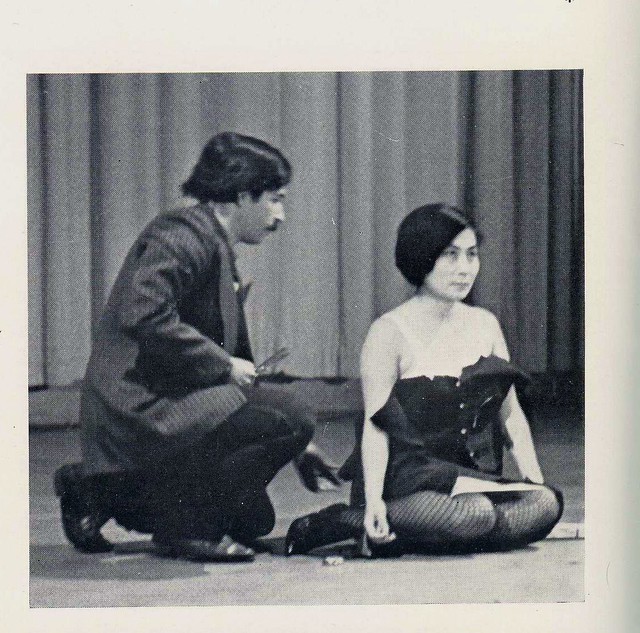

“Cut Piece” (’65) by Yoko Ono for “INSTRUCTIVE AUTO-DESTRUCTION” by Anthony Cox in “Art and Artists”, August, 1966
How does it change the viewer’s relationship to the work?
In “Cut Piece”, viewers were invited to participate and profoundly shape the final outcome of an ‘artwork’ in a very direct manner. The complexity and implications of the piece were radical and groundbreaking as the artist has dedicated her body as the subject. Traditionally, when a viewer interacts with a piece of work, the nature of the interaction reflects the viewer’s state of mind in terms of aesthetic, mood etc. However, in “Cut Piece”, the viewer’s interactions signified much more. It was a manifestation of his/her desires; the uninhibited nature of one’s self. In the collective form, the total effect of viewers’ actions portrayed a certain sense of the anarchy and primal, chaotic nature of the human psyche. Such an effect would be hard to achieve with an inanimate subject in the same rein. The fact that there are real tangible stakes(the well-being of another person) involved in the process and outcome of the piece, brings out other aspects like societal inhibitions and collective psychological behaviours of its participants. In essence, it’s a social, science and art experiment all at the same time; ‘speaking your mind’ in the utmost sense.
How does it alter the way an artist or designer create the work, when there is an interactive component?
The work becomes much more experiential for the viewer, and the outcomes are indefinitely varied with each iteration. The process takes center stage, and the result may or may not become inconsequential. There is a shared sense of deeper meaning being derived; shared because each participant’s actions influences the one that comes after, and deeper meaning as there are layered meanings accumulated as the work progresses. The artist cedes much control to chaos, and the typical process is turned on its head. Here, the artist decides the starting variables and allows the process to occur organically. There is no inkling of what might happen and what the end result resembles. Interestingly, a simple parable of such a mechanism in the real world would be a presidential election(subject). The candidates(variables) are shortlisted, and the people(participants) vote accordingly to their judgement(emotion/logic). The results(final outcome) can be pretty arbitrary and unexpected, yet it reflects the collective wisdom and perceptions of the society in question.
A derivative of this seminal piece was Marina Abramović’s Rhythm 0(1974). Here, Marina altered the variables, by placing 72 objects on a table for her participants to use. There were ‘positive’ and ‘negative’ objects, allowing her viewers to perform good or detrimental acts. The narrative here is further intensified, as the objects reminded the participants that they could either do good or evil. The emphasis on moral choices is central to the eventual outcome. It became potently clear that the reminder was inconsequential. Most people were inherently ‘savage’ by nature.
On a lighter note, interaction can be employed as a way of facilitating dialogue(verbal and otherwise) between artist, viewers and society. As such, the artist ‘designs’ the central idea and interactions as perimeters, and presents it as a live petri dish, after which, may decide to perform an interpretation on the outcome(s). The exploration happens on a participatory level, as opposed to the traditional singular point of view.

